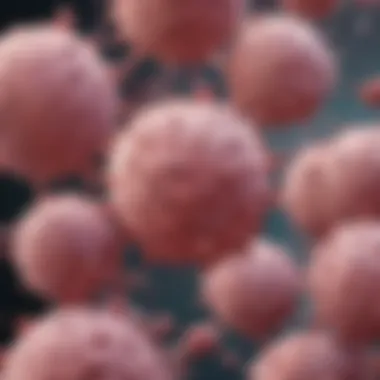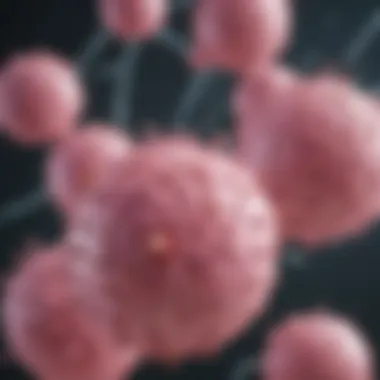Adjuvant Chemotherapy in Triple Negative Breast Cancer


Intro
Adjuvant chemotherapy plays a crucial role in managing triple negative breast cancer, a subtype known for its aggressive nature and lack of targeted treatments. Understanding the interplay between chemotherapy and TNBC characteristics is vital for enhancing treatment efficacy. This analysis focuses on several fundamental aspects: the distinct features of TNBC, how adjuvant chemotherapy operates, the results of clinical trials, and considerations that guide treatment decisions. Moreover, this article will also address the management of potential side effects associated with treatment and highlight emerging areas of research that could shape future therapies.
Triple negative breast cancer accounts for about 15% of all breast cancer diagnoses. A lack of three main hormone receptors contributes to its challenging treatment landscape. Despite this complexity, adjuvant chemotherapy has shown promise in improving overall survival rates among patients. The upcoming sections will dissect these issues systematically, offering insights into the potential of adjuvant chemotherapy within this specific patient population.
Methodology
Overview of Research Methods Used
The research blends qualitative and quantitative methodologies to provide a well-rounded perspective on adjuvant chemotherapy in TNBC. Key steps included analyzing existing literature, incorporating meta-analyses of clinical trial data, and conducting interviews with oncologists specialized in breast cancer treatment. This comprehensive approach offers a thorough understanding of treatment protocols and patient experiences.
Data Collection Techniques
Data was primarily gathered through:
- Review of peer-reviewed journals and clinical trial results.
- Online databases such as PubMed and ClinicalTrials.gov for the latest studies.
- Surveys targeting oncologists to gather real-world treatment decisions and outcomes.
This collection method ensures that various perspectives are considered, allowing for a detailed and nuanced examination of the topic.
Future Directions
Upcoming Trends in Research
Future research is gradually moving towards precision medicine, aiming to tailor treatments based on the genetic profile of tumors. Increased emphasis on immunotherapies and their potential synergy with chemotherapy is also gaining traction. Clinical trials are investigating novel combinations, particularly those that might enhance effectiveness for TNBC patients.
Areas Requiring Further Investigation
Research should also focus on:
- Long-term survivorship and the psychosocial impact of adjuvant chemotherapy.
- Developing strategies to combat drug resistance in TNBC.
- Clarifying the role of neoadjuvant versus adjuvant chemotherapy in treatment pathways.
Understanding these areas is essential to advance treatment and improve outcomes.
"Continued collaboration among researchers, oncologists, and patients will be vital to push the boundaries of current knowledge in treating triple negative breast cancer effectively."
Understanding Triple Negative Breast Cancer
The significance of understanding triple negative breast cancer (TNBC) cannot be overstated. TNBC accounts for about 15% of all breast cancer cases. It is distinct in its lack of estrogen, progesterone, and human epidermal growth factor receptor 2 (HER2) receptors. This absence complicates treatment options since standard hormonal therapies and HER2-targeted therapies are ineffective. Consequently, comprehension of its characteristics helps in tailoring more effective therapeutic strategies, particularly for adjuvant chemotherapy.
Adjuvant chemotherapy holds considerable importance in TNBC treatment. By targeting rapidly dividing cancer cells, this approach aims to eliminate any remaining tumor cells post-surgery. It reduces the risk of recurrence, which is notably significant for TNBC due to its aggressive nature. Thus, enhancing the understanding of TNBC characteristics allows for optimized treatment selection and improved patient outcomes.
Definition and Characteristics
Triple negative breast cancer is defined by its unique biological profile. As mentioned earlier, TNBC is characterized by the absence of receptors for estrogen, progesterone, and HER2. Patients diagnosed with TNBC often present with tumors that have poorer prognosis when compared to other types of breast cancer. The average age of diagnosis is generally lower, often occurring in younger women.


Key characteristics include:
- Histological Type: TNBC most frequently presents as invasive ductal carcinoma.
- Grade: High-grade tumors are common, meaning they show aggressive growth patterns.
- Metastatic Potential: TNBC may spread more aggressively, with metastases often occurring in the lungs, liver, and brain.
Epidemiology and Risk Factors
Epidemiological studies reveal that TNBC disproportionately affects certain demographics. African American women, for instance, are more likely to be diagnosed with TNBC compared to Caucasian women. Additionally, factors such as age, obesity, and family history contribute to risk.
Research indicates a higher incidence in women under 40, highlighting a need for awareness and early detection in younger populations.
Common risk factors include:
- Genetics: Mutations in the BRCA1 gene significantly elevate risk levels.
- Reproductive Factors: Early menstruation, late menopause, and nulliparity can increase susceptibility.
- Lifestyle Factors: Excessive alcohol consumption and sedentary lifestyle are associated with increased risk.
Genetic Underpinnings
The genetic basis of TNBC is complex. It often involves mutations that contribute to the aggressive nature of the disease. One notable genetic factor is the mutation of the BRCA1 gene. This mutation not only raises the likelihood of developing breast cancer but particularly increases the risk for triple negative subtypes.
Other significant genetic alterations may include:
- TP53 gene mutations: These are commonly found in TNBC, affecting tumor suppressor functions.
- PIK3CA mutations: Although less common in TNBC than other breast cancer types, they can still play a role in tumor behavior.
Understanding these genetic factors is essential for researchers and clinicians to develop targeted therapies and improve patient care. Knowledge of the genetic profile assists in identifying high-risk populations who may benefit from more intensive monitoring and preventive measures.
The Role of Adjuvant Chemotherapy
Adjuvant chemotherapy plays a pivotal role in the management of triple negative breast cancer (TNBC). The aggressive nature of TNBC, characterized by its distinct biological behavior and lack of targeted therapy options, necessitates an effective treatment strategy. Here, the focus shifts to understanding the purpose and goals of adjuvant chemotherapy, followed by examining its mechanism of action.
Purpose and Goals
The primary purpose of adjuvant chemotherapy in TNBC is to eliminate residual cancer cells after the surgical removal of the primary tumor. The goals are multifaceted:
- Reduce recurrence risk: Adjuvant therapy aims to decrease the likelihood of cancer returning in the same or different sites, thus improving long-term survival rates.
- Improve overall survival: By addressing microscopic disease that might remain post-surgery, adjuvant chemotherapy can extend the lives of patients with TNBC.
- Enhance curative potential: For patients with locally advanced or high-risk cancer, adjuvant therapy can be a critical component of a curative approach.
In addition to these direct goals, adjuvant chemotherapy contributes indirectly by facilitating subsequent treatment options, such as radiation therapy or hormonal treatments if applicable.
Mechanism of Action
Adjuvant chemotherapy works through several mechanisms aimed at disrupting cancer cell proliferation. The most common chemotherapeutic agents used in TNBC include doxorubicin, cyclophosphamide, and paclitaxel. Here’s how they function:
- DNA Interference: Many chemotherapy drugs interfere with the cancer cell's DNA replication process. This interference can lead to cell death, particularly in rapidly dividing cells, which is a hallmark of cancer.
- Mitotic Inhibition: Certain agents prevent cancer cells from completing mitosis, ultimately leading to apoptosis or programmed cell death.
- Targeting Cancer Cells: While not selective, adjuvant chemotherapy is designed to target cells that divide more rapidly than normal cells. Though some normal cells are affected, the overall goal is to maximize damage to cancer cells.
"Understanding the mechanism of action of chemotherapy agents is crucial for selecting appropriate regimens for TNBC, given its unique pathobiology."
Clinical Evidence
Clinical evidence plays a critical role in understanding and improving treatment strategies for triple negative breast cancer (TNBC). It encompasses data from robust clinical trials that assess the efficacy of adjuvant chemotherapy, providing insights into treatment benefits and drawbacks for patients with this aggressive form of cancer. By examining these trials, healthcare professionals can make more informed decisions related to patient care, tailoring treatment plans to enhance outcomes.


Key Clinical Trials
Several landmark clinical trials have shaped the treatment landscape for TNBC. Among these, the Adjuvant Chemotherapy for Early-Stage Triple-Negative Breast Cancer: Results from the CALGB 40603 Trial stands out. This study involved patients receiving either standard chemotherapy or an experimental regimen integrating carboplatin. The results indicated that adding carboplatin improved pathologic complete response rates compared to standard treatment alone.
Other notable studies include the SWOG S1314 Trial, which explored the use of pembrolizumab, an immunotherapy, in combination with chemotherapy for TNBC patients. This trial revealed promising survival benefits, particularly in tumors expressing PD-L1.
Furthermore, the APHINITY Trial focused on the addition of pertuzumab to standard chemotherapy regimens. While not exclusively for TNBC, it offered insights into the effect of targeted therapies on improving disease-free survival.
These trials collectively contribute to a better understanding of how adjuvant chemotherapy can be optimized for TNBC, emphasizing the importance of personalized medicine based on individual tumor biology.
Outcomes and Survival Data
The survival data gleaned from clinical trials highlight the potential of adjuvant chemotherapy in prolonging overall survival rates in patients with TNBC. For instance, studies have indicated that patients who achieve a pathologic complete response after neoadjuvant chemotherapy generally have significantly improved long-term outcomes.
Recent analysis from the FDA Oncology Center of Excellence supports this observation, noting that patients treated with adjuvant chemotherapy showed a marked reduction in the risk of recurrence. Specifically, a meta-analysis demonstrated a relative risk reduction of approximately 25% in recurrence rates among those receiving adjuvant chemotherapy compared to those who did not.
However, it is vital to consider the heterogeneity within TNBC itself. Not every patient will respond positively to the same treatment regimen. Thus, continuous efforts in refining treatment protocols according to specific tumor characteristics and patient profiles are necessary.
Factors Influencing Treatment Decisions
Understanding the factors that influence treatment decisions for adjuvant chemotherapy in patients with triple negative breast cancer (TNBC) is critical for improving patient outcomes. Each decision made in the treatment process can greatly affect the efficacy of the therapy and the overall prognosis of the patient. Factors such as tumor characteristics, the patient's performance status, and their comorbidities and preferences are essential metrics that guide oncologists in tailoring therapy.
Tumor Characteristics
Tumor characteristics are paramount in determining the appropriateness of adjuvant chemotherapy. Key factors include tumor size, grade, and lymph node involvement. Larger tumors or those with higher grades often suggest a more aggressive disease. For example, tumors that exhibit lymphovascular invasion may respond favorably to chemotherapy. The expression of specific biomarkers, such as Ki-67 proliferation index, can also shed light on the tumor's behavior and thus its likely response to treatment. Clinicians must meticulously assess these parameters, as they play a vital role in the decision-making process regarding therapy intensification or modification.
Patient Performance Status
The performance status of a patient is another crucial determinant in treatment planning. This is typically assessed using scales like the Eastern Cooperative Oncology Group (ECOG) performance status, which evaluates a patient's level of functioning. A patient deemed to have a good performance status is often able to endure aggressive treatment regimens. Conversely, those with a poor performance status may face higher risks of treatment-related toxicity. Adequately evaluating this aspect helps balance the risks and benefits associated with adjuvant chemotherapy. Additionally, quality of life considerations must be addressed, as the burden of treatment should be weighed against its potential benefits.
Comorbidities and Patient Preferences
Comorbidities significantly impact treatment choices. Patients may have concurrent health issues that necessitate adjustments to chemotherapy regimens. For instance, individuals with cardiovascular problems may need a chemotherapy approach that minimizes cardiac stress. It is essential for healthcare providers to carefully assess such factors and consider them in the treatment planning process. Alongside medical factors, patient preferences must also be taken into account. These preferences can include a desire for a particular treatment method, concerns about side effects, or a wish for participation in clinical trials. Engaging patients in discussions about their treatment options fosters a more collaborative approach, enhancing adherence to the chosen treatment plan.
"Patient-centered care involves actively involving the patient in all conversations regarding their treatment and decisions."
In summary, factors influencing treatment decisions in adjuvant chemotherapy for TNBC are multi-faceted. Careful evaluation of tumor characteristics, performance status, comorbidities, and patient preferences enables a more personalized and effective treatment strategy. This not only aims to improve clinical outcomes but also enhances the overall treatment experience for patients.
Side Effects and Management
In the context of adjuvant chemotherapy for triple negative breast cancer (TNBC), the discussion on Side Effects and Management is crucial. Understanding the potential side effects not only informs patients and families about what to expect but also aids healthcare providers in creating effective management plans. Potential side effects can impact a patient's quality of life, treatment adherence, and overall outcomes. As such, proactive management strategies are essential to alleviate discomfort and address complications.
Common Side Effects
Adjuvant chemotherapy employs various drug regimens, leading to multiple possible side effects. Some of the most commonly reported side effects for patients undergoing treatment include:


- Fatigue: One of the most prevalent side effects. This can range from mild tiredness to debilitating exhaustion, impacting daily activities.
- Nausea and Vomiting: Many patients experience GI disturbances. While antiemetic medications may help, some patients still struggle with these symptoms.
- Hair Loss: Alopecia can be distressing. The extent varies based on the chemotherapy regimen.
- Changes in Appetite: Patients may either lose interest in food or experience increased hunger. This can affect nutritional status and weight.
- Increased Risk of Infection: Chemotherapy can cause neutropenia, a reduction in white blood cell counts, elevating infection risk.
- Mucositis: Inflammation or ulceration in the mouth and digestive tract is a painful side effect, often requiring intervention.
Understanding these side effects allows healthcare professionals to offer targeted support and interventions. For example, regular monitoring of blood counts can help prevent infections and manage side effects early, while nutritional counseling can help address changes in appetite.
Supportive Care Strategies
Management of side effects is imperative for maintaining treatment efficacy and patient quality of life. Several supportive care strategies can play an essential role in this process:
- Patient Education: Informing patients about potential side effects before treatment enables them to recognize symptoms early and seek assistance.
- Pharmacological Interventions: The use of medications such as antiemetics for nausea, growth factors for neutropenia, and analgesics for pain management can greatly improve patient comfort.
- Psychosocial Support: Addressing emotional and psychological well-being is vital. Support groups and counseling can help patients cope with the emotional toll of treatment.
- Nutritional Support: Engaging a dietitian ensures that patients receive proper dietary guidance to maintain strength and address changes in appetite.
- Holistic Approaches: Integrative approaches, such as acupuncture, stress management techniques, and physical therapy, may relieve symptoms like fatigue and pain.
Proper management of side effects is a vital part of the chemotherapy process, impacting both adherence to treatment and overall patient satisfaction.
In summary, recognizing and addressing the side effects of chemotherapy is a crucial component in managing the treatment of TNBC. By implementing effective strategies, healthcare professionals can significantly improve patient experiences and outcomes.
Future Directions in Treatment
Exploring Future Directions in Treatment for adjuvant chemotherapy in triple negative breast cancer is crucial. This section discusses how evolving approaches can improve patient outcomes and therapeutic effectiveness. Given the aggressive nature of TNBC, the quest for innovative treatment options remains paramount. New strategies and therapies have the potential to personalize treatment, increase survival rates, and minimize side effects.
Novel Therapeutic Approaches
Recent advancements in oncology research bring forth novel therapeutic approaches tailored for triple negative breast cancer. One promising area is the integration of immunotherapy with traditional chemotherapy regimens. Immunotherapeutic agents, such as pembrolizumab and atezolizumab, have shown potential in enhancing the immune response against TNBC cells. These agents act by inhibiting checkpoints that normally regulate immune activity, thereby enabling the immune system to target cancer cells more effectively.
Additionally, targeted therapies that focus on specific genetic mutations within TNBC are being investigated. For instance, the potential role of PARP inhibitors, like olaparib, shows efficacy in patients with BRCA1 or BRCA2 mutations. The understanding of TNBC's genetic landscape will likely lead to more effective targeted therapies in the near future.
Furthermore, combination therapies involving agents that tackle different pathways could improve treatment efficacy. These approaches necessitate extensive clinical research to establish the most effective combinations and their impact on survival outcomes.
Ongoing Clinical Trials
Ongoing clinical trials are integral to shaping the future of treatment for triple negative breast cancer. Current studies are evaluating various combinations of chemotherapy, immunotherapy, and targeted agents. For example, trials are focusing on the safety and efficacy of combining pembrolizumab with standard chemotherapy in neoadjuvant settings.
These trials play an essential role in providing data on survival rates, progression-free survival, and overall patient quality of life. Results from such studies will be pivotal for establishing new treatment protocols that are evidence-based.
In addition, multinational trials aim to recruit diverse patient populations to assess the effectiveness of treatments in different demographics. Understanding responses across various ethnic backgrounds will enrich the literature around TNBC and ensure that therapeutic strategies are inclusive and widely applicable.
The End
The conclusion of this article draws together the essential elements discussed regarding adjuvant chemotherapy in the context of triple negative breast cancer (TNBC). By summarizing the key findings, it reinforces the importance of understanding TNBC’s unique challenges and the role adjuvant therapies play in addressing these issues. Adjuvant chemotherapy is vital in enhancing overall patient survival, especially given the aggressive nature of TNBC.
Factors such as tumor characteristics and patient preferences are crucial in making informed treatment decisions. The discussion also emphasizes the ongoing need for research in this area, highlighting the dynamic nature of cancer treatment. Future investigations into novel therapeutic approaches may open new pathways and offer much-needed hope for patients battling TNBC.
Summary of Key Findings
The analysis reveals several critical insights:
- Adjuvant chemotherapy significantly improves survival rates in TNBC patients.
- Tailoring treatment to individual tumor characteristics and patient conditions is essential.
- Management of side effects is necessary for maintaining quality of life during treatment.
- New therapeutic approaches and clinical trials are on the horizon, potentially changing the treatment landscape.
All these findings underline the necessity of a multidimensional approach in the treatment of TNBC, where both clinical evidence and patient perspectives are integrated into practice.
Implications for Clinical Practice
The implications for clinical practice are far-reaching. Healthcare professionals must remain updated with the latest clinical trials and emerging therapies in this field. Furthermore, there is an imperative to adopt a patient-centered approach in treatment decisions, considering both medical and individual factors. This helps optimize therapy effectiveness and minimizes the risks associated with aggressive treatment options.
It is also essential to enhance supportive care strategies to manage side effects effectively. This ensures patients can endure rigorous treatment while maintaining a reasonable quality of life. Ultimately, the knowledge shared in this article is aimed at informing professionals and prompting ongoing dialogue, ultimately improving patient outcomes in TNBC.







